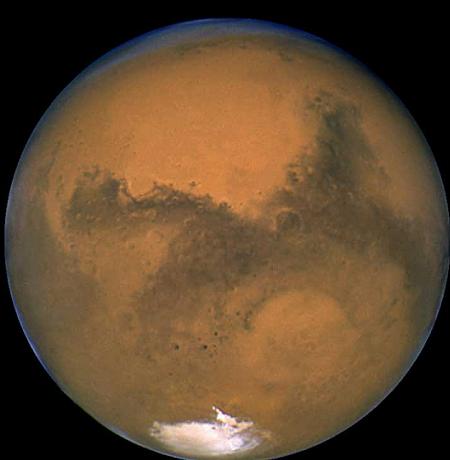A scientist from the University of Michigan is part of a European Space Agency team that discovered methane gas on Mars, the findings will be published in the Internet publication Science Express Today
Ariel Eisenhandler, Israel Astronomical Society

Sushil Atreya, professor and director of the Laboratory for Planetary Science in the College of Engineering says that the discovery of methane is the most convincing sign so far of the possibility of life on the surface of the Red Planet.
"Methane that is produced biologically is one of many possibilities for its creation," says Atria. "Methane is a possible biomarker. If a planet has methane we start to think about the possibility of life on it. On the surface of the Earth, methane is produced almost entirely from biological sources."
Mars is more like Earth than any other planet in our solar system and studying its atmosphere gives us a better understanding of our own.
The big question is: But did the methane reach Mars? Atria says there are several possible sources. The most exciting scenario is that methanogens, bacteria that consume the hydrogen and carbon monoxide on Mars for energy and emit methane, reside in out-of-sight colonies under the surface of the Red Planet.
"These bacteria are anaerobic (exist without air) and therefore do not need oxygen, all this assuming they are there," says Atria. "If so, then they are below the surface."
Despite the temptation of this assumption, many experiments must be performed before any conclusions are reached. "Despite the tantalizing thought that there are living things on Mars, we are not in a position where we can say that this is what causes methane," says Atria.
Atria adds that there is a possibility that a comet hit the planet, which would leave behind methane, but that happens once every 60 million years or so.
A much more likely scenario is that a hydrothermal process (activity of solutions and hot gases), which includes an interaction between rock and water, occurred in the aquifer layer (an underground layer of rock that serves as a water source) under the polar region of Mars, where the ground does not thaw throughout the year.
The device that "sniffed" and discovered the methane is called the Fourier Planetary Spectrometer (a French mathematician and physicist who lived at the end of the 18th century), which is one of the seven devices on the European Space Agency's "Mars Express" spacecraft. The spectrometer measures the ultraviolet sunlight absorbed, emitted and scattered by molecules in the Martian atmosphere. Each molecule has a unique spectral feature, like a fingerprint, including methane.
The spectrometer found an average of 10 parts of methane per billion in average volume content on Mars (Parts Per Billion by Volume -ppbv - ie: for every billion parts in a certain volume measured there are 10 parts of methane), a small amount compared to the amount of approximately 1700 ppbv on Earth. Atria says that the methane is distributed unevenly on the surface of Mars, which tends to support the theory that an internal source - located in a certain place - is the one that creates the methane and not a comet that hit Mars.
The Mars Express spacecraft was launched in June 2003 and is the first Western European spacecraft to travel to another planet.
